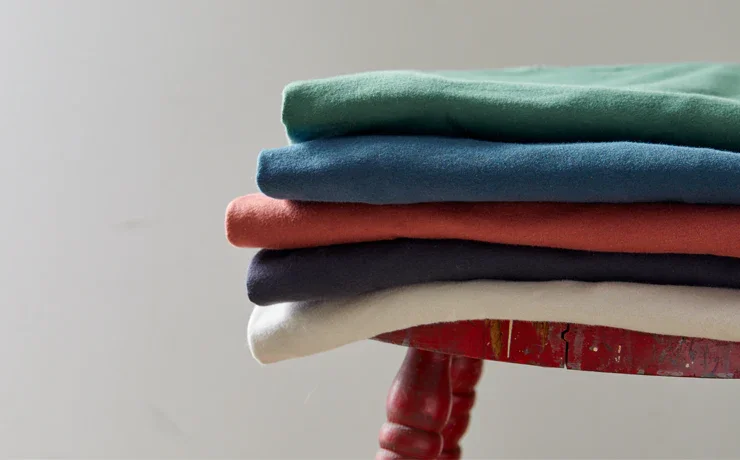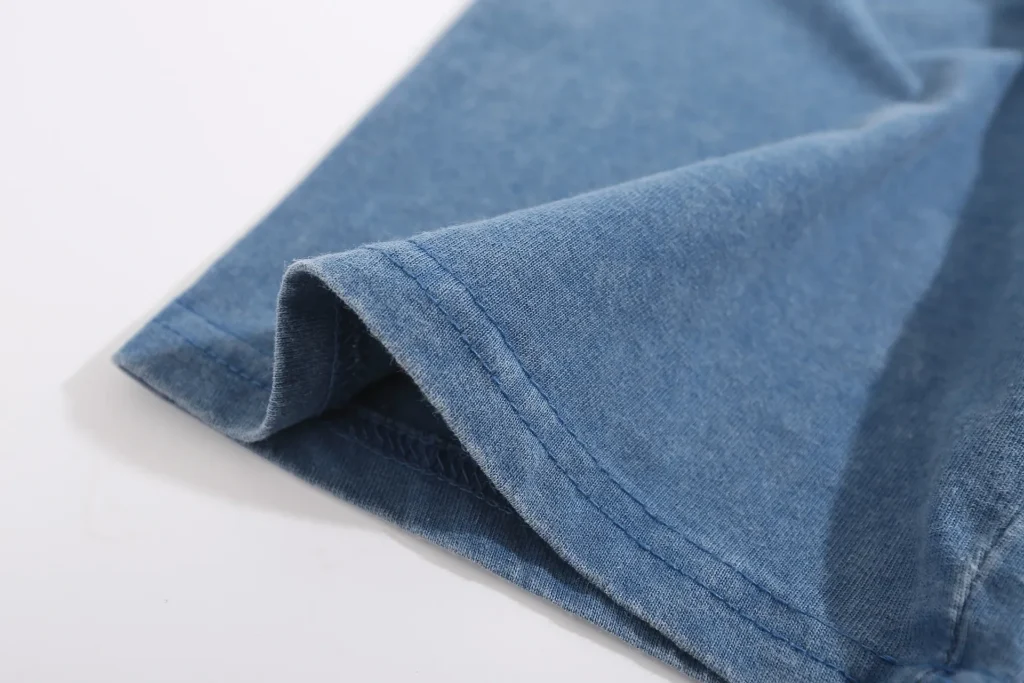No products in the basket.
T-Shirt Guide
How Much Does A Shirt Weigh? Average Shirt Weight Guide
Having often found myself packing for long trips and often shipping goods, I have come to see how much weight and expenses may vary depending on even the tiniest factors. I started wondering one day while getting ready a shipment: how much does a shirt weigh? Though it sounds small, every pound counts whether you are computing shipping costs or trying to satisfy rigorous airline luggage limits.
How little I knew about something so basic startled me. Without knowing the typical weight of various kinds of shirts, one runs the danger of overpacking or perhaps underestimating shipping expenses. Ignorance can result in more taxes, larger bags, and, quite honestly, a lot of pointless trouble. That motivated me to investigate and distribute this knowledge since knowledge of shirt weight would enable anyone to avoid these annoying problems.
The Average Weight Of A Shirt
I had no idea there were so many elements to take into account when first trying to ascertain the weight of a shirt. As it happens, not all shirts are made alike; variations in size, fabric, and design can all greatly affect weight. This greatly affects how one plans for things like travel packing or shipping expenses.

Why Shirt Weight Varies
The material a shirt is manufactured from will greatly affect its weight. For instance, while polyester and other synthetic blends can add some more weight, cotton shirts usually lean lighter. Thicker fabrics like fleece or flannel add even more bulk, hence heavier textiles like these could perform better for winter wear but might become a headache when packing.
Size also counts; an XL shirt naturally weights more than a small one. This is particularly crucial for me while packing since some big shirts might occupy as much weight and space as a whole stack of smaller ones. Some shirts are heavier than others depending on design details including double-layered fabrics, extra buttons, or embroidery. For shipping, even these little variations might influence expenses; hence, knowing these elements allows me to better plan.

General Shirt Weight By Type
Understanding the typical weight for different types of shirts has helped me prepare better for shipping and travel.
- Shirts: Most of my shirts are pretty lightweight, usually between 4 to 6 ounces (113 to 170 grams). The lighter ones, especially plain cotton tees, make excellent options when I need to keep things light. I’ve found that thicker cotton or heavy-duty shirts weigh closer to 7 ounces, which can add up if I’m packing several.
- Button-down Shirts: These tend to be a bit heavier than shirts. My standard cotton button-downs often weigh around 7 to 8 ounces, while flannel and thicker styles can push up to 10 ounces (283 grams). Button-downs are great for style, but I’ve noticed their weight can make a difference if I’m watching my luggage limits or shipping costs.
- Sweaters and Hoodies: These are by far the heaviest. Even a lightweight sweater is usually around 12 ounces (340 grams), and hoodies can go well over a pound. When I’m shipping a box of clothing or packing for a colder destination, hoodies and sweaters are always the pieces I have to budget my weight and space around the most.
How Fabric And Material Influence Shirt Weight
As I began to pay more attention to shirt weight, I soon discovered that fabric choice clearly affects things. Every kind of material feels and weights differently; knowing these variations enables me to better arrange my shipment and packing.

Cotton Vs. Polyester Vs. Blends
Cotton is my go-to for most shirts because it’s lightweight and breathable. A basic cotton shirt often weighs between 4 and 6 ounces, which makes it an easy choice when I’m trying to pack light. On the other hand, polyester, though lightweight, has a slightly heavier feel due to its denser weave and is often more durable. When I pack polyester shirts, I notice they add a bit more weight than pure cotton.
Blends—such as cotton-polyester mixes—offer a middle ground, giving the breathability of cotton with the durability of polyester. These blends tend to weigh a bit more than pure cotton but are often lighter than full polyester shirts. When I’m packing for trips, I usually consider blends if I want something that holds up well without being too heavy.
Specialty Fabrics
For less common fabrics, the weight varies quite a bit, and I’ve learned to adjust my expectations based on the material. Linen, for example, is a great summer fabric, but it’s bulkier than cotton and tends to wrinkle, adding both weight and volume to my luggage. Wool shirts, on the other hand, are much heavier and best suited for colder climates, as a single wool shirt can weigh nearly double what a cotton or polyester shirt does.
These specialty fabrics are great for specific uses, but I find myself thinking twice about packing them, especially if I need to stay within a weight limit for a flight or when shipping. Understanding these weights has saved me from unexpected baggage fees and extra shipping charges more than once.
Shirt Size And How It Changes Weight
When I began paying attention to shirt weights, I noticed how much size alone could affect the overall weight. A larger shirt means more fabric, which adds up quickly, especially when packing or shipping several items at once.

Comparing Sizes: Small To Extra-Large
Across standard sizes, the difference in weight is more noticeable than I initially expected. A small cotton shirt might weigh around 4 ounces, but as the sizes go up, so does the weight. By the time you reach an extra-large, the same shirt can weigh closer to 6 or even 7 ounces. When I’m shipping or packing for a longer trip, I try to account for these differences, especially if I have multiple large shirts in the mix. I’ve learned that balancing sizes or mixing lighter and heavier shirts makes a big difference when space or weight is tight.
Children’s Vs. Adult Sizes
Packing for kids is a bit easier, as children’s shirts are naturally lighter due to their smaller size. For family trips, I’ve found that packing children’s clothing, even for multiple kids, weighs less overall than packing for just one adult. A kid’s shirt might weigh just a couple of ounces, while an adult shirt is often double or triple that. However, packing several children’s items together can add up, so I’ve learned to distribute the weight carefully, especially for flights where every pound matters.
Knowing these size differences has helped me plan smarter, whether I’m shipping a box of mixed sizes or packing for a family vacation.
FAQs About How Much Does A Shirt Weigh
A Shirt Weighs On Average What?
Typically depending on size, fabric, and thickness, a shirt’s average weight is between 4 and 7 ounces (113 to 198 grams). While heavier, thicker materials weigh more, lightweight cotton tees are sometimes on the less end.
An Adult Hoodie Weights What?
With thicker, fleece-lined choices on the heavier side, an adult hoodie typically weights 16 to 24 ounces (450 to 680 grams). Hoodies add greater weight, which is crucial to take into account while packing or computing delivery.
Does Shirt Weight Change Greatly Depending On Size?
Indeed, shirt weight can rise noticeably in bigger sizes. A small shirt might weigh 4 ounces, for instance, whereas an XL variation of the same shirt might weigh about 6 or 7 ounces. Greater overall weight results from larger sizes using more cloth.
Conclusion
For shipping and packing effectively, knowing the weight of a shirt has changed everything. Understanding that elements like fabric kind, size, and design all affect weight has helped me make better decisions that will save money and effort down road. This knowledge surprisingly affects my planning whether it comes to maximize luggage space or estimate delivery costs. This breakdown should enable you to feel more ready the next time you are packing for a trip or sending out an order.
For a more visual guide on this topic, check out this helpful video:

I am Estelle Krattinger, a multi-talented creative artist from Paris, France. Known for my captivating photography and enchanting storytelling, I have garnered a dedicated following on Instagram, where I share glimpses of my artistic journey and creative pursuits. With an impeccable eye for detail and a passion for exploring the beauty in the mundane, my work showcases my unique perspective and artistic vision.
